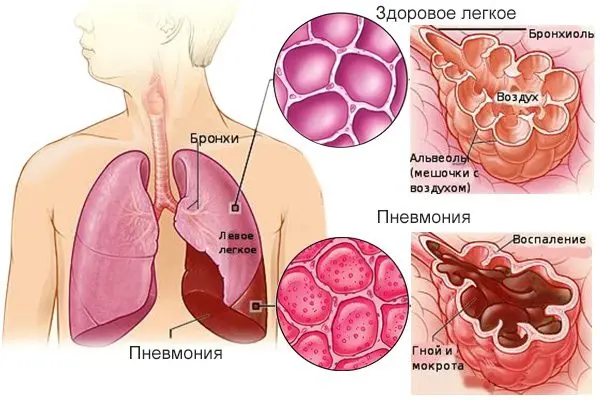
Pneumonia is an inflammation of the lungs, a dangerous disease that can be fatal. Inflammation is most often caused by bacteria and viruses. Lack of treatment can lead to serious consequences. Therefore, it is so important to know all the signs that the disease manifests itself.
Pneumonia is caused by an infection in the lungs. Pathogenic flora can be represented by viruses, bacteria or fungi. The respiratory organs react to the attack with inflammation, during which fluid begins to accumulate in the alveoli. The normal passage of the air flow becomes impossible, which leads to the appearance of the first symptoms of pneumonia.

ICD-10: J12, J13, J14, J15, J16, J17, J18, P23.
ICD-9: 480-486, 770.0
The main route of transmission of the infection that causes pneumonia is airborne. The spreader releases viruses and bacteria into the air when talking, coughing or sneezing. These particles, invisible to the naked eye, fall on the mucous membranes of a healthy person, after which they reach the lungs.
The hematogenous route of transmission of the disease is not excluded. In this case, the infection spreads through the blood from other sources of inflammation present in the body. The cause of pneumonia can be bacteria living in the nasopharynx.
How to recognize the very first signs of incipient pneumonia?
Early on in the development of the disease, symptoms can vary in intensity. What matters is the age of a person, the state of his immune system, the characteristics of the body as a whole. Pneumonia can manifest acutely, while the patient’s well-being deteriorates sharply. In other clinical cases, the disease develops slowly, over several days or even weeks.

The first symptoms to suspect pneumonia:
Cough that persists for days or weeks. Over time, it does not stop, but gains strength. Cough can be different: with or without sputum, frequent and rare.
hyperthermic reaction. Fever with an increase in body temperature up to 39-40 degrees is not excluded. In other cases, it remains at the level of subfebrile condition (37 – 37,5 degrees).
Shortness of breath, feeling short of breath.
Increased fatigue.
Wheezing.
Rhinitis, pain and sore throat.
Confusion of consciousness.
Unwillingness to eat, nausea, loose stools.
Allergist-immunologist Ilyintseva N.V. at Allegris Medical Center: cough or pneumonia?









